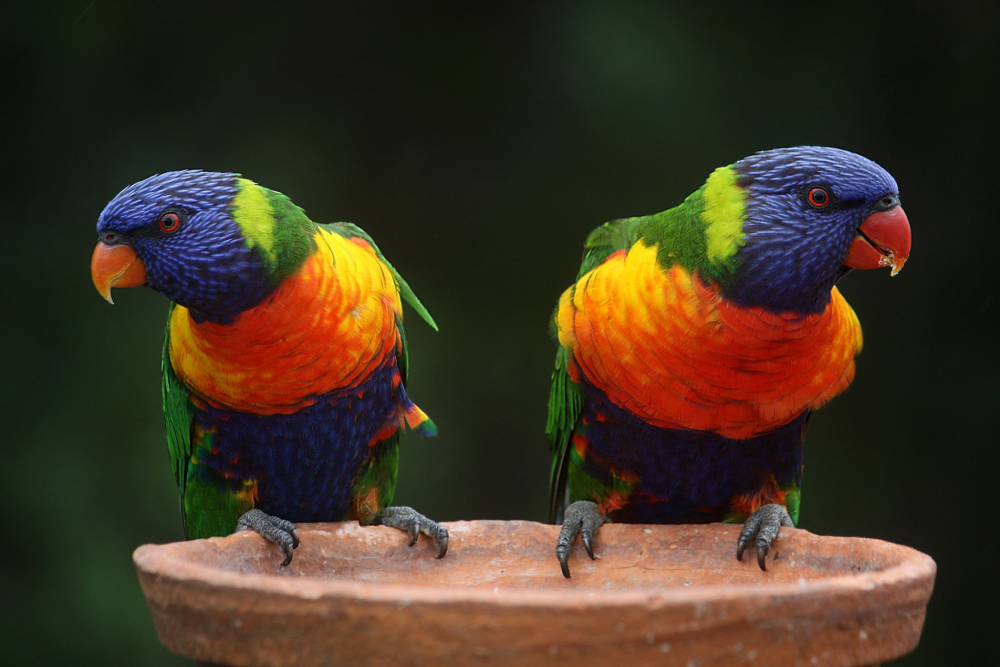Appearance
The Rainbow Lorikeet is aptly got his name for its stunning array of colors. Its plumage features a vibrant combination of red, blue, green, orange, and yellow hues, resembling a living rainbow in flight. The feathers are not only visually striking but also serve as effective camouflage in their natural habitat, blending seamlessly with the foliage of the Australian forests they inhabit. Their slender, curved beaks are perfect for feeding on the nectar and pollen of various flowering plants, which constitute a significant portion of their diet.
Habitat and Distribution
These charismatic birds live in the dense forests, woodlands, and coastal regions of Australia. They have also been introduced to parts of New Zealand, where they have established feral populations. Within their native range, Rainbow Lorikeets exhibit a preference for habitats with abundant flowering trees and shrubs, as these provide both food and nesting sites. Their adaptability to urban environments has seen them thrive in parks, gardens, and even suburban areas, where they are often welcomed as delightful visitors by humans.

Social Behavior
Rainbow Lorikeets are highly social birds, often gathering in large flocks that can number in the hundreds. These flocks are not only a means of protection against predators but also serve important social functions, providing opportunities for mating, communication, and learning from one another. Within these flocks, individuals engage in a variety of behaviors, including playful interactions, vocalizations, and elaborate courtship displays during the breeding season.
Diet and Feeding Habits
One of the most fascinating aspects of Rainbow Lorikeet behavior is their specialized feeding habits. Unlike many other parrot species, which primarily feed on seeds and nuts, Rainbow Lorikeets are nectarivores, meaning that the majority of their diet consists of nectar from flowers. Their unique brush-tipped tongues are perfect for extracting nectar from deep within blossoms, allowing them to access this rich source of energy. In addition to nectar, they also consume pollen, fruits, berries, and occasional insects, providing them with a well-rounded diet.
Breeding and Reproduction
Breeding season for Rainbow Lorikeets typically occurs between August and January in their native range. During this time, pairs form monogamous bonds and engage in elaborate courtship rituals, which may involve synchronized flights, vocalizations, and mutual preening. Once a pair has bonded, they will search for a suitable nesting site, often in tree hollows or crevices. Both male and female lorikeets participate in nest construction, using twigs, leaves, and other materials to create a cozy nest chamber.
Conservation Status
While Rainbow Lorikeets are not endangered, they face several threats to their long-term survival. Habitat loss due to urbanization, deforestation, and agriculture poses a significant risk, as it reduces the availability of suitable nesting sites and food sources. Additionally, the illegal pet trade has resulted in the capture of wild lorikeets for the exotic pet market, further impacting wild populations. Conservation efforts aimed at protecting their natural habitat, enforcing wildlife protection laws, and raising awareness about the importance of preserving biodiversity are crucial for ensuring the continued survival of these magnificent birds.
Conclusion
In the vast tapestry of the natural world, the Rainbow Lorikeet shines as a radiant testament to the beauty and diversity of life. With its dazzling colors, charming personality, and remarkable adaptations, this iconic parrot species serves as a vivid reminder of the wonders that await those who take the time to explore and appreciate the rich tapestry of life on Earth. As stewards of our planet, it is our responsibility to ensure that these magnificent birds, and all creatures great and small, continue to thrive for generations to come.









